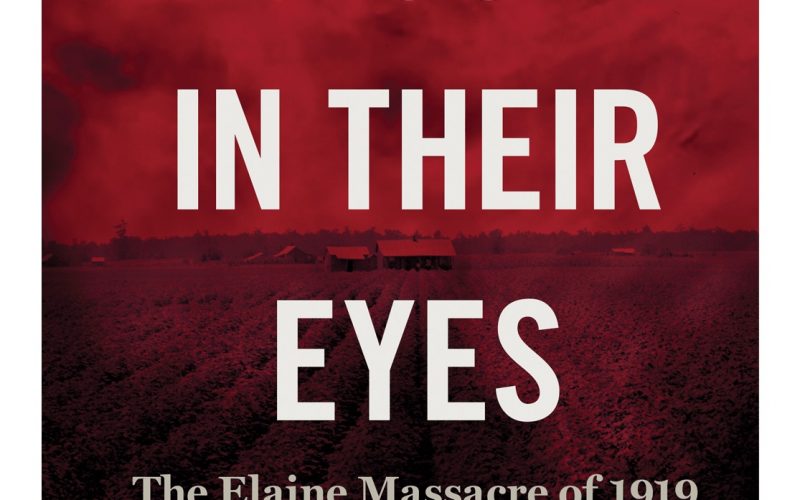Retelling of Elaine Massacre brings new revelations
BECCA MARTIN-BROWN
bmartin@nwadg.com
“The Elaine Massacre was clearly the deadliest incident of the ‘Red Summer’ of 1919, a series of white supremacist riots and massacres that occurred all across America,” Guy Lancaster begins the history lesson. “It may have been the deadliest single incident of racial violence in American history.”
According to the University of Arkansas Press, publisher of Lancaster’s new edition of “Blood in Their Eyes: The Elaine Massacre of 1919,” “on Sept. 30, 1919, local law enforcement in rural Phillips County, Arkansas, attacked black sharecroppers at a meeting of the Progressive Farmers and Household Union of America. The next day, hundreds of white men from the Delta, along with U.S. Army troops, converged on the area ‘with blood in their eyes.’ What happened next [left] a legacy of trauma and silence that has persisted for more than a century.”
The incident called the Elaine Massacre came to renewed public attention in 2001, when Grif Stockley wrote the original edition of “Blood in Their Eyes.” But the story still was not complete. Lancaster, editor of the Encyclopedia of Arkansas with the Central Arkansas Library System, and Brian K. Mitchell, assistant professor of history at the University of Arkansas at Little Rock, drew from recently uncovered source material for an update, published in May, which “explores in greater detail the actions of the mob, the lives of those who survived the massacre, and the regime of fear and terror that prevailed under Jim Crow.”

Historians Guy Lancaster (pictured) and Brian K. Mitchell have updated Grif Stockley’s revelatory 2001 book, “Blood in Their Eyes: The Elaine Massacre of 1919.” Both of them will speak via Zoom Sept. 30 for a Fayetteville Public Library-hosted University of Arkansas Press Author Spotlight.
(File Photo)
Lancaster and Mitchell will speak “virtually” Sept. 30 for a Fayetteville Public Library-hosted University of Arkansas Press Author Spotlight. Last week, Lancaster took time to answer these questions via email for The Free Weekly.
Q. If you grew up in Arkansas or the South, when you were a kid in school, did you ever hear of the Elaine Massacre? Do kids now hear about this polarizing event or do you think we still get a sterilized version of history?
A. I grew up in Arkansas but didn’t hear about the Elaine Massacre until I was in graduate school and Grif Stockley presented at an academic conference we were putting on. I think that most people still encounter this story as adults. In fact, the other day, I was conversing with a woman from the Elaine area who had not heard of the story until recent years, despite having ancestors involved, as she later learned.
I think one of the reasons that people don’t typically hear of this story is that it’s hard to make the Elaine Massacre another “exception” within our narrative of national progress. Anything that’s potentially embarrassing, we Americans tend to relegate to the level of exception. Think about how we talk about slavery. It’s an exception to the nation — we only had it in the South. It’s an exception to the population — even in the South, most people didn’t own slaves. And it’s an exception to our history — we eventually got rid of it, right? This ignores the fact that the American and world economy were deeply implicated in, and dependent upon, slavery. It doesn’t matter that most white men of the South weren’t slave owners; the money generated from plantation slavery drove everything from local businesses in the South to the industrial centers of the North. You could not escape slavery.
With something like the Elaine Massacre, it’s hard to sanitize it because it’s harder to cast it into the role of exception. It happened in the 20th century, one year after the Great War, the War to End All Wars. It wasn’t just rural, backwoods mobs going rampant. Business leaders in Phillips County were directing much of the violence. Charles Brough, a progressive governor, called in federal troops to put down what he was told was a “Negro insurrection.” And it’s likely that those troops engaged in mass killings. The Elaine Massacre doesn’t really accord with how we want to understand American history, and so it continues to be ignored by many.
Q. What was it about this incident that was so significant?
A. The Elaine Massacre was clearly the deadliest incident of the “Red Summer” of 1919, a series of white supremacist riots and massacres that occurred all across America. It may have been the deadliest single incident of racial violence in American history. And the legal battle that followed resulted in the 1923 U.S. Supreme Court case of Moore v. Dempsey that changed how due process was to be understood. Before Moore v. Dempsey, simply going through the motions of a trial was permitted — it didn’t matter if the courtroom was beset by mobs promising to murder a defendant if he was released; if the defendant had a formal trial, then he could not appeal his case. However, in 1923, the court reversed course and insisted that a defendant’s constitutional rights were dependent not only upon a formal “corrective process,” but a fair one. It’s a decision that has reverberated down to the present day.
Q. How did the publication of the original edition of this book in 2001 spark revelations?
A. I believe that the 2001 edition was a revelation in and of itself, as many people, even well-informed historians, knew little to nothing about the massacre. It spawned, thus, a determination not only to incorporate the massacre into the history we teach and write, but also to research the system of racial and economic exploitation even more.
Q. What made it time for a new edition of the book?
A. Of course, the centennial commemoration of the massacre last year sparked a renewed interest in the event. But on top of that, in the years since Grif’s original book, significant research has been done on the broader field of racial violence in Arkansas, thus giving greater context for what happened at Elaine. In addition, my colleague and co-author Brian Mitchell has uncovered a wealth of new primary sources that shed new light upon what happened at Elaine.
Q. What does this edition include that even those who know about the incident will find surprising or revealing?
A. We knew that the American Legion played a significant role in the perpetration of the massacre, as its members were deputized by the sheriff. But we did not know how great a role they played in the coming years. One of our discoveries was of a minutes book from the American Legion in which they wrote about petitioning Governor Brough to ensure that the 12 African-American men sentenced to death for their supposed role in the “Negro insurrection” would not be granted any reprieve in the slightest.
Q. What do you hope this book brings to the table as far as discussions on race, equality and all those other topics that are weighing so heavily on this country right now?
A. I believe that the best way to advance as a civilization is to understand the complex history that has resulted in the numerous social divisions present in our society, for by properly understanding the cause, we might effect a cure. However, many people believe that teaching the truth about what happened constitutes a fundamental assault upon their identity. For example, just last week, Donald Trump launched a White House Conference on American History, during which he lambasted scholarly books that challenged some of the myths we have been taught, insisting that they are “propaganda tracts” designed “to make students ashamed of their own history.” Some people insist upon teaching only “patriotic history.” OK, but how do you teach the history of lynching and massacre in a patriotic fashion? Just a few days after the massacre, the “patriotic” narrative was perhaps best encapsulated with the newspaper headline: “Vicious Blacks Were Planning Great Uprising.” We know that this was a lie perpetrated by the local business elite and repeated by every individual and institution invested in the cause of white supremacy. No one is trying to make people ashamed of being American by saying that. But you won’t be able to understand present circumstances — and, thus, transcend them — unless you understand the violence that was done in the past. We Americans have, in the past, prided ourselves on our “can-do spirit,” the idea that we can achieve any goal with enough hard work and fortitude. But that spirit seems to die when it comes to the legacy of exploitation and oppression. Why? Why can’t we summon enough courage to confront our collective demons? Because people like Donald Trump believe that our best days as a nation are behind us, and he is determined to preserve that legacy from any challenges. I, however, believe that our best days are ahead of us. And I hope that this book plays some small role in getting us there.
FYI
Read More About It
“Blood in Their Eyes: The Elaine Massacre of 1919” is available at uapress.com for the list price of $27.95. It is currently sale priced at $20.96.
FAQ
UA Press Spotlight:
‘Blood in Their Eyes’
WHEN — 6 p.m. Sept. 30
WHERE — Fayetteville Public Library via Zoom
COST — Free
INFO — Register at faylib.org










